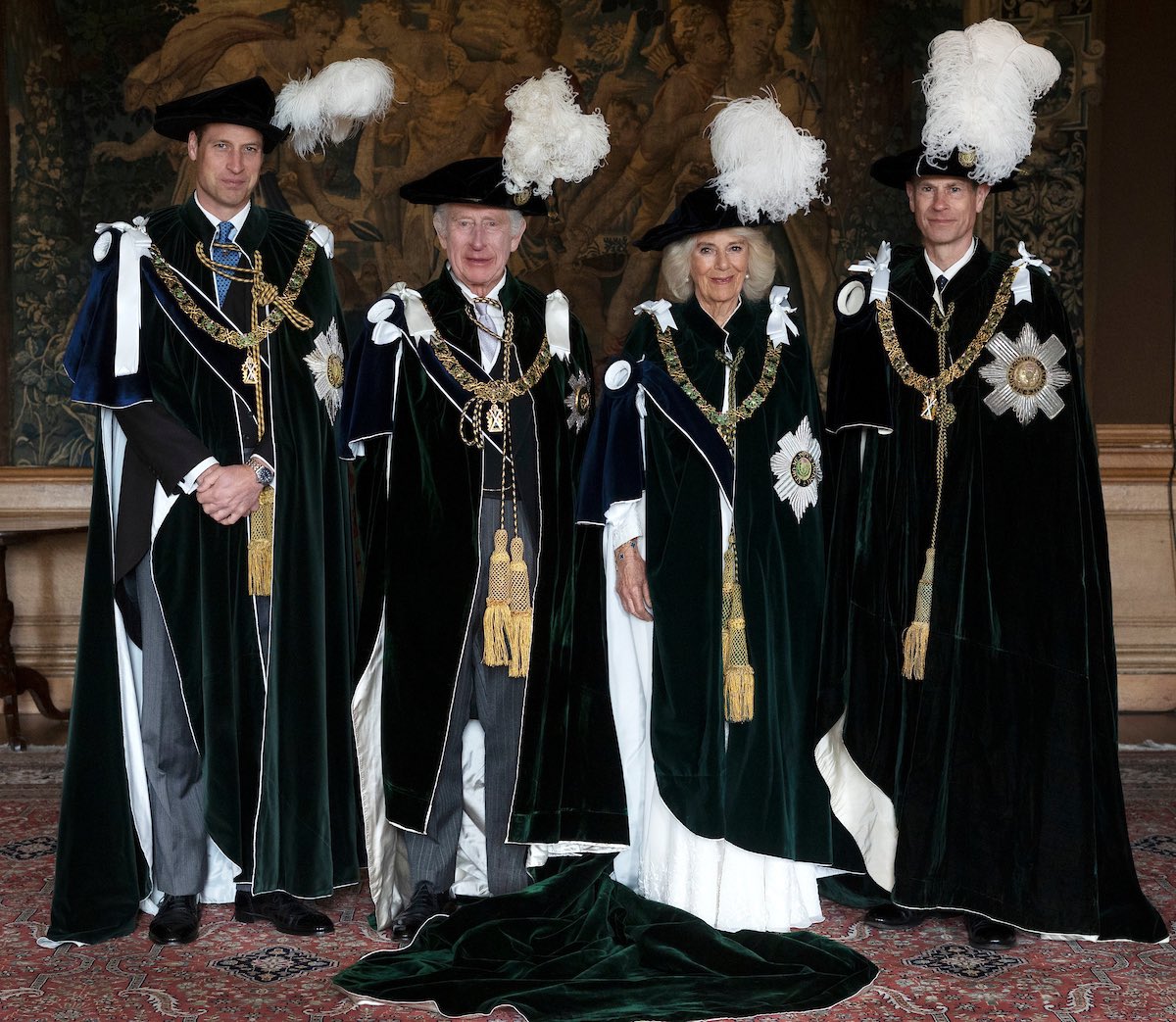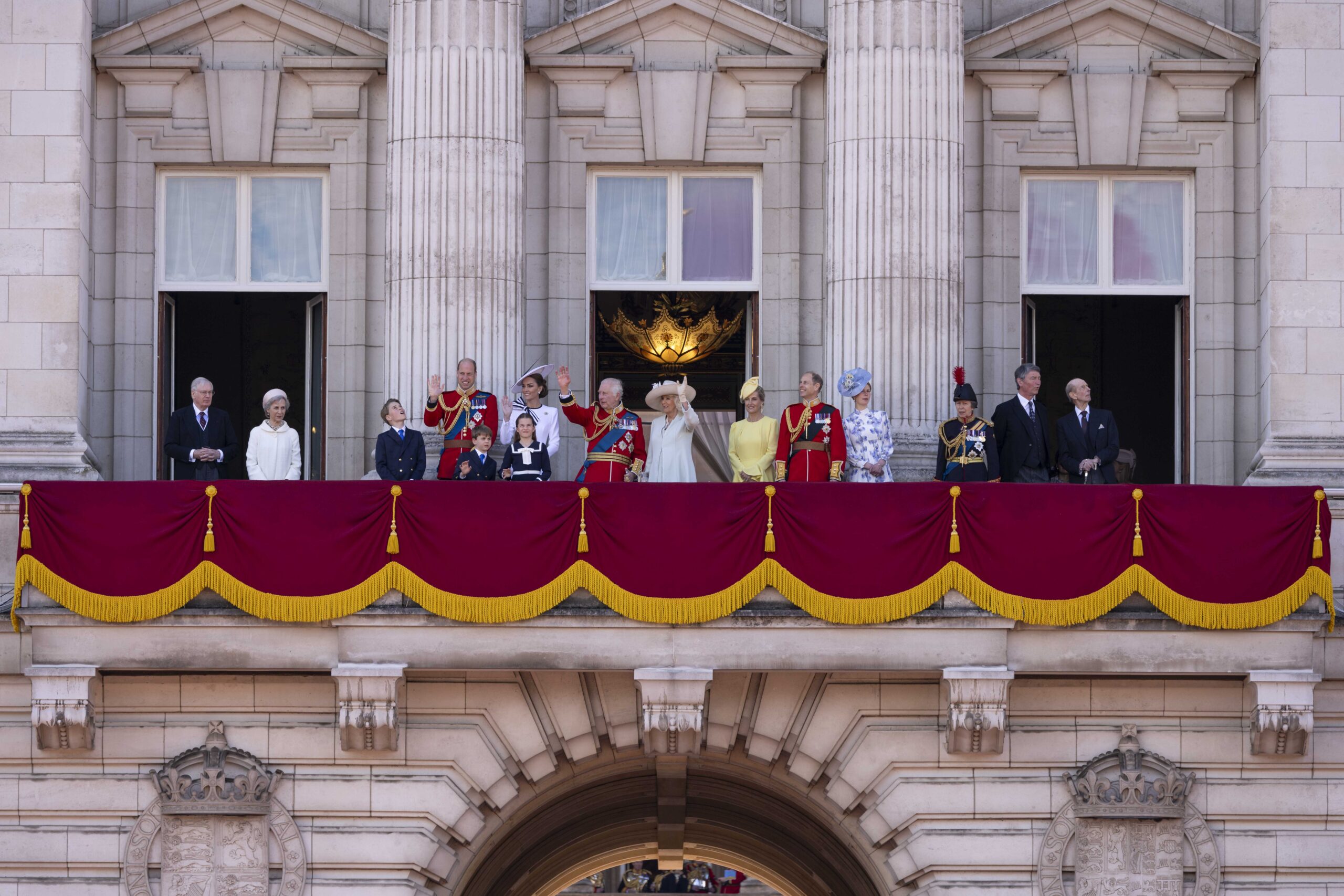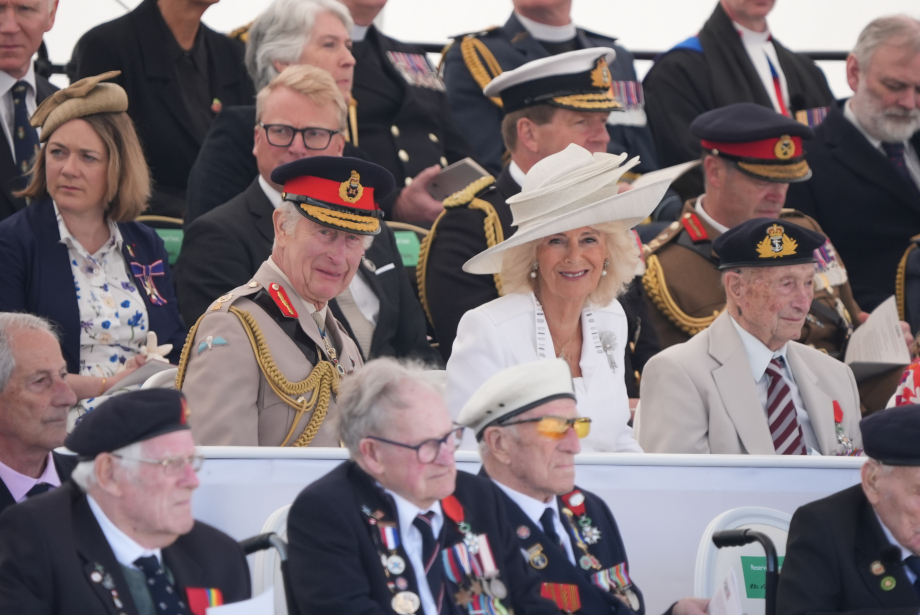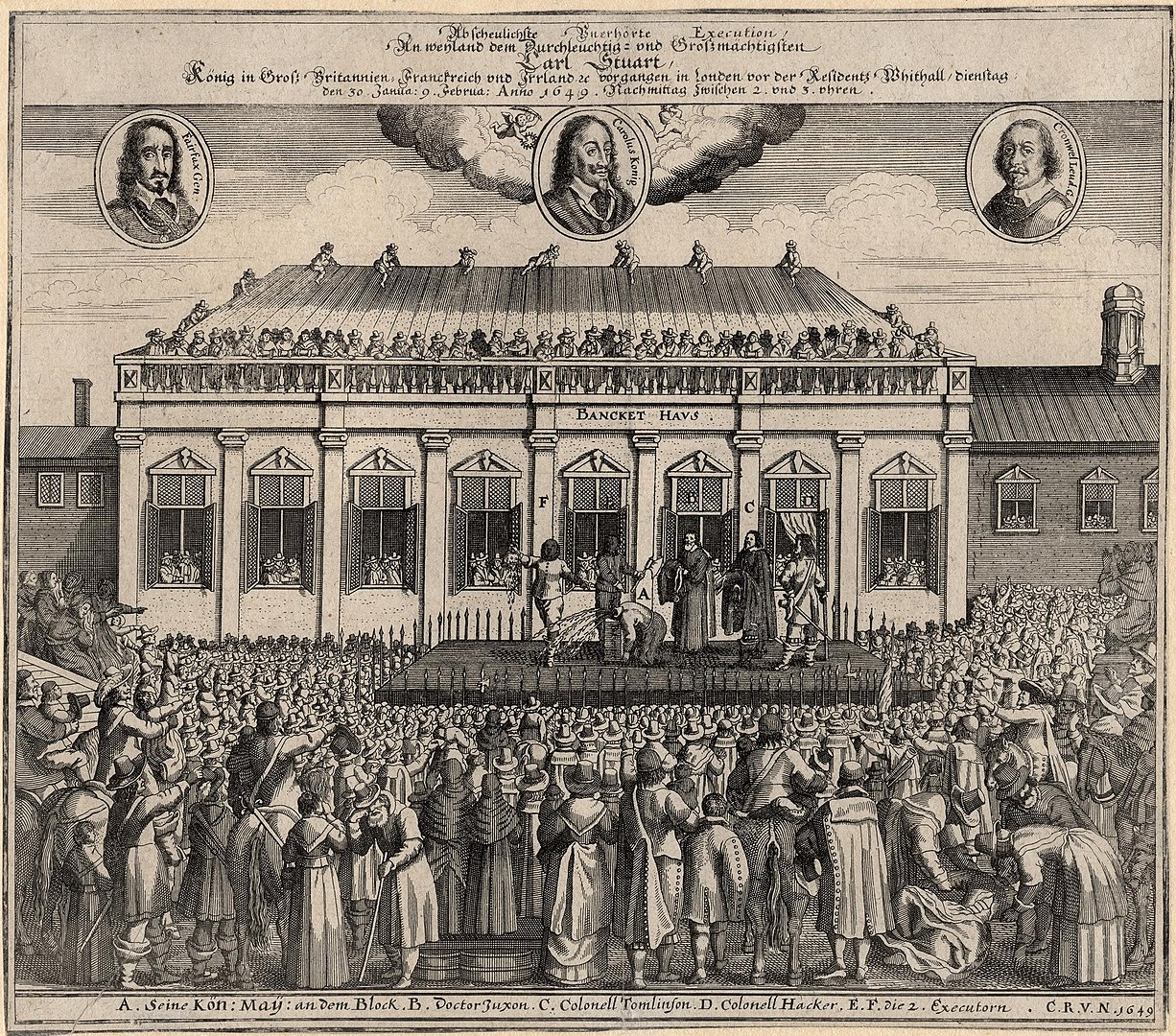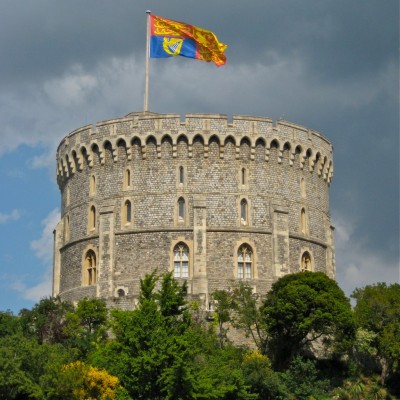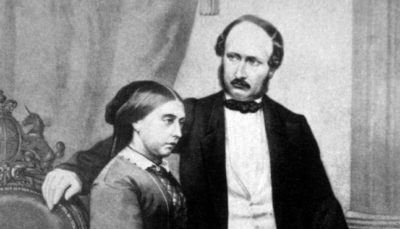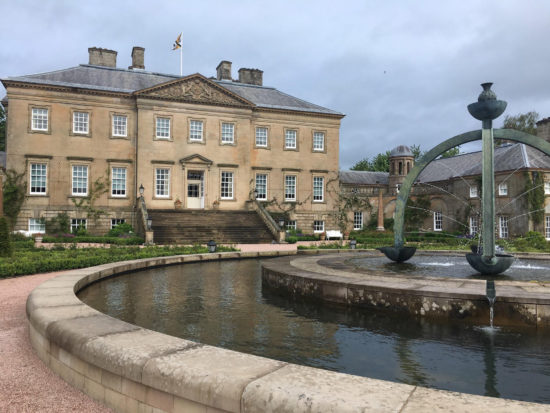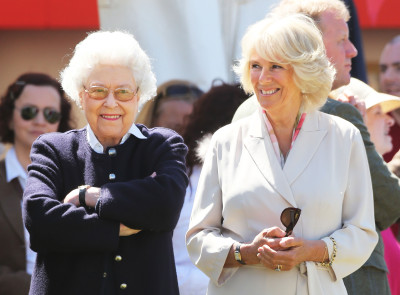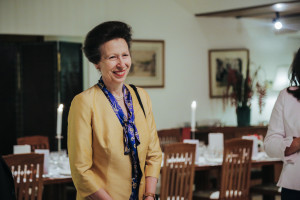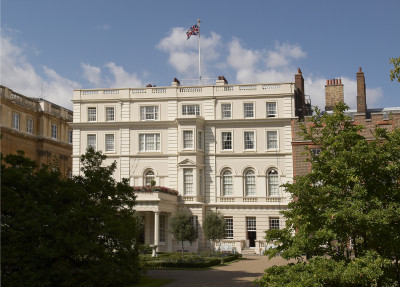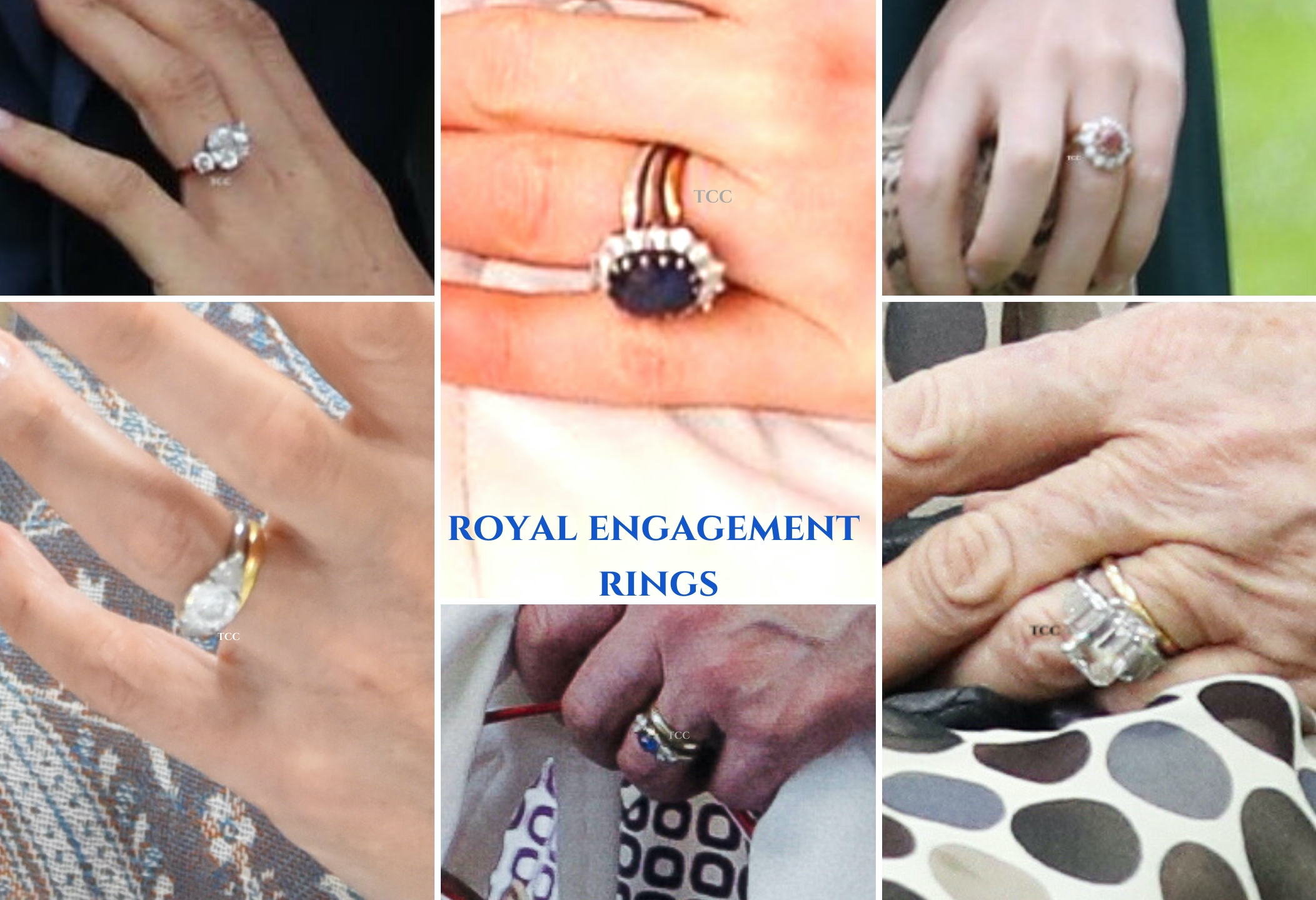Prince Charles and Camilla visited the ‘Seven Portraits: Surviving the Holocaust’ exhibition at The Queen’s Gallery, Buckingham Palace on Monday.
The Prince of Wales recently commissioned the portraits of seven Holocaust survivors as a living memorial to the victims of the Shoah. He is Patron of the National Holocaust Memorial Day Trust.

Prince Charles speaks to Anita Laskar-Wallfischof next to her portrait at The Queen’s Gallery (Clarence House)
The royal couple viewed the seven paintings, and met with the sitters and artists involved in the project. The sitters are all Holocaust survivors, who have been given honours for their services to Holocaust awareness and education. The subjects are:
– Arek Hersh MBE, who was 11 and living in Sieradz, Poland, when the Second World War broke out. As part of a Jewish family, he spent time in the Lodz ghetto, before being sent to Auschwitz-Birkenau concentration camp, where he was selected to work including ploughing and in the fisheries.
Nine days before the camp was liberated, in January 1945, Arek was sent on the Death March to Germany. Reaching Katowice, Arek and the other prisoners were put into goods wagons and taken to Buchenwald. In April, he was forced onto another Death March from Buchenwald, and put onto a wagon at Weimar. Eventually reaching the Sudetenland in Czechoslovakia, he was moved to the Terezin Ghetto and finally liberated four days later.
Arek’s older sister, Mania, was the only other family member who survived; the pair were reunited in Ulm, Germany, in 1947. He now lives in England with his family.

Arek Hersh by Massimiliano Peronti; the artist wanted to ‘depict Arek in his own environment, in the intimacy of his usual daily routine, which might lead the viewer on a narrative journey of his life’.
– Helen Aronson BEM was evacuated from Pabjanice to the notorious Lodz ghetto in 1942. Helen is one of only 750 Jews who miraculously survived the ghetto, from a total of 250,000 who entered it. Her father was murdered at Chelmno concentration camp, together with all of Pabjanice’s children, whom he had volunteered to accompany. Helen managed to survive the ghetto alongside her mother and brother, as slave workers.
After being liberated from Lodz by the Red Army, her mother joined her older sister in Israel and her brother went to Australia. In 1946, Helen began her new life in London where she joined her uncle and learnt English. She married, worked as a secretary and had two daughters. In 1954, Helen, her husband George and their two daughters – Monica and Annie – moved to Lagos, Nigeria, where George had been posted with the colonial service.

Paul Benny depicted Helen Aronson. He said had to match Helen’s ‘joyful disposition’ with an ’emphasis on light and
colour’ to ‘match her vitality’.
– Anita Lasker-Wallfisch MBE was born in Breslau, then Germany. One of three musical daughters, she had private cello tuition in Berlin at the age of 12 with the only remaining Jewish cello teacher in the city. Kristallnacht meant Anita left Berlin to return to her family in Breslau, where she was forced to leave school and was conscripted to work in a paper factory.
In 1942, Anita’s parents were deported to Izbica near Lublin, where they were killed on arrival. Anita began resistance activities during this time, mainly forging paperwork for French prisoners of war. Realising that the Nazis had been watching her, Anita forged papers for herself and attempted to escape but she was quickly caught and imprisoned for forgery, helping the enemy, and attempted escape. After a year in prison, she was sent to Auschwitz. She credits her survival at Auschwitz to the fact that she was able to join the camp orchestra. The prisoners who were part of the orchestra played by the gates of the camp as the other prisoners left for work in the morning and arrived back in the evening. The orchestra was also expected to be on call to play whenever a member of the SS wanted to hear music.

Portrait of Anita Laskar-Wallfischof, part of the Seven exhibition, by Peter Kuhfeld
From Auschwitz, Anita was sent to Bergen-Belsen, which was liberated by British troops in April 1945. After serving as an interpreter for the British army, she settled in the UK in 1946 where she achieved fame as cofounder and member of the English Chamber Orchestra.
Peter Kuhfeld has completed a number of previous royal commissions, including the wedding of Prince William and Catherine Middleton (2011), The Queen’s Diamond Jubilee River Pageant (2012), and the christening of Prince George (2013).
– Rachel Levy BEM was raised in rural Czechoslovakia in the heart of the Carpathian Mountains. Her father was taken from their home in 1942 during the war, leading to her family hiding in the mountains and forests successfully for a time. However, in spring 1944, her neighbours handed the family over to the Nazis; the family were taken to Auschwitz, where Rachel’s mother, Shlima, her sisters Rivka and Eta and her infant brother Ben-Zvi were all gassed upon arrival. Rachel was separated from her brother, Chaskel, and uncle, and sent to the female section of the camp. As the war neared its end and the allied forces approached, those remaining in the camp were sent on the infamous Death March. 21 days of walking took Rachel and the other survivors to Bergen-Belsen, which was liberated in 1945 by British troops; 60,000 inmates were freed.
After the war, Rachel and her brother travelled to the UK as refugees.

Portrait of Rachel Levy by Stuart Pearson Wright, who said it was ‘extraordinary privilege’ to spend time with her
– Lily Ebert BEM was the eldest daughter in a family of six children. In July 1944, when Lily was 14, she was deported to Auschwitz with her mother, younger brother and three sisters. Lily and two of her sisters were sent to work, but the rest of the Eberts were sent to the gas chambers. Lily managed to keep her shoes after being stripped of her possessions, in which a golden cherub pendant, given to her by her mother, was hidden. It was the only trace of her mother she had left. When her shoes wore out, Lily hid the pendant in a piece of bread.
Four months after arriving in the camp, Lily and her two sisters were transferred to a munitions factory at Altenburg, near Leipzig for slave labour. After liberation in spring 1945, Lily travelled with her surviving sisters to Switzerland to start rebuilding her life. In 1953 Lily was reunited with her older brother, who had survived the Nazi camp system, and the family then moved to Israel. In 1967 Lily and her husband moved to the UK.

Portrait of Lily Ebert, by Ishbel Myerscough who wanted to ‘show
the layers of experience and complexity of her life’ and ‘capture her infectious energy’.
– Manfred Goldberg BEM was born into Orthodox Jewish family in Kassel, Germany. His father was able to escape to Britain in August 1939, just days before the war began, but the rest of the family were unable to join him. The persecution continued and the situation deteriorated following the outbreak of the war, and in 1940 Manfred’s Jewish school was closed by Nazi authorities.
In December 1941, Manfred, his mother and brother were deported to the Riga Ghetto in Latvia. Life here was characterised by lack of food, use as slave labour and constant fear, including random mass shootings. Despite this, Manfred was able to celebrate his Bar Mitzvah in March 1943. In August 1943, just three months before the ghetto was finally liquidated, he was sent to a nearby labour camp where he was forced to work laying railway tracks.

Manfred Goldberg by Clara Drummond. The artist said she was stories of the people Manfred thought helped save his life that ‘were most memorable’
As the Red Army approached Riga, Manfred and the other surviving prisoners were evacuated to Stutthof concentration camp near Gdańsk, Poland in August 1944. He spent more than eight months as a slave worker in Stutthof, being forces onto a Death March just before the war came to an end. He was finally liberated at Neustadt in Germany in May 1945.
He came to Britain in September 1946 to be reunited with his father. After learning English, he managed to catch up on some of his missed education and he eventually graduated from London University with a degree in Electronics. He is married with four sons and several grandchildren.
Clara Drummond painted this image, and has previously been commissioned by Prince Charles for a D-Day veteran portrait in 2015.
– Zigi Shipper BEM was born to a Jewish family in Łódź, Poland and attended a Jewish school. When he was five years old his parents divorced but, because they were Orthodox Jews and divorce was frowned upon, he was told that his mother had died. Following his parents’ divorce, he lived with his father and his grandparents.
When war broke out, Zigi’s father escaped to the Soviet Union, believing only young Jewish men would be at risk; however, the following year, Zigi and his grandparents were forced to move into the Łódź Ghetto. His father attempted to return to see Zigi but could not get into the ghetto; he never saw his father again and still does not know what happened to him

Zigi Shippers’s portrait, painted by Jenny Saville
In 1942, the children of the ghetto were rounded up and put on lorries to be deported. Zigi managed to jump off the lorry and escaped back into the ghetto, where he remained, working in the metal factory, until the ghetto’s liquidation in 1944. At this point, he and the remaining group were sent to Auschwitz-Birkenau and processed through selection for either work or the gas chamber. A few weeks after arriving, all of the surviving workers from the metal factory were sent to Stutthof concentration camp, where Zigi volunteered to work at a railway yard, meaning her was able to get more food.
With the Soviets advancing, Zigi and the rest of his group were sent on a Death March, arriving in the German naval town of Neustadt. A British air attack here caused chaos, but Zigi soon realised the Nazis had left, and the British troops liberated the group on 3rd May 1945. Three days after liberation, Zigi ended up in hospital for three months due to the effects of overeating after a long period of malnutrition. Once he left hospital, he and his friends were sent to a Displaced Persons’ camp.
Zigi arrived in the UK in 1947, where he married and had a family. He now lives in Hertfordshire and regularly shares his testimony in schools across the country.
The future King wrote the foreword to the catalogue, calling the portraits ‘a permanent reminder for our generation – and indeed, to future generations – of the depths of depravity and evil humankind can fall to when reason, compassion and truth are abandoned’.

Arek chats to The Duchess of Cornwall next to his portrait, commissioned by Prince Charles to mark the Holocaust victims and survivors (Clarence House)
Speaking of his motives for the project, Charles wrote: ‘My abiding hope is that this special collection will act as a further guiding light for our society, reminding us not only about history’s darkest days, but of humanity’s interconnectedness as we strive to create a better world for our children, grandchildren and generations as yet unborn; one where hope is victorious over despair and love triumphs over hate’.
This work overlaps with The Duchess of Cambridge’s recent work; she contributed to the ‘Portraits of the Holocaust’ exhibition, depicting Holocaust survivors and their families. Catherine has previously met Zigi and Manfred when she and Prince William visited Stutthof concentration camp in 2017 during their visit to Germany.
Duchess of Cambridge highlights ‘strength and bravery’ of Holocaust survivors in emotional reunion
Camilla also recently gave an impassioned speech to mark Holocaust Memorial Day. The Duchess of Cornwall said in her speech: “Let us not be bystanders to injustice or prejudice. After all, surely our personal values are measured by the things we are prepared to ignore. Let us therefore learn from those who bore witness to the horrors of the Holocaust, and all subsequent genocides, and commit ourselves to keeping their stories alive, so that each generation will be ready to tackle hatred in any of its terrible forms.
“And let us carry with us the words and wisdom Anne Frank (a child of only 14 years old) wrote on 7th May 1944: ‘What is done cannot be undone, but at least one can prevent it from happening again’.”
The portraits will become part of the Royal Collection, which is held in trust by The Queen for the nation. Here, they will ‘stand as a powerful testament to the extraordinary resilience and courage of those who survived’, Clarence House says.
A programme documenting their creation will be shown on BBC 2 tomorrow, to mark National Holocaust Memorial Day.
You can see the portraits if you visit until 13th February, when it will head to Edinburgh and Holyroodhouse from 17th March to 6th June. Admission to the display is included with a ticket to the current exhibition at The Queen’s Gallery, Masterpieces.

